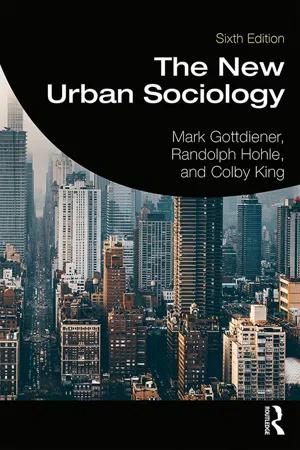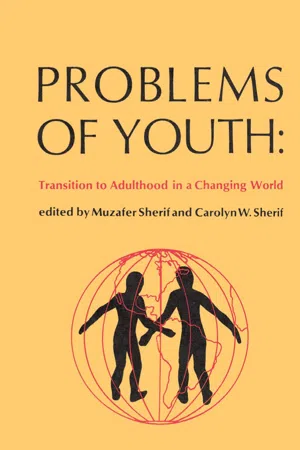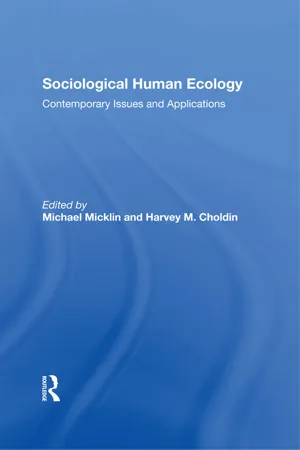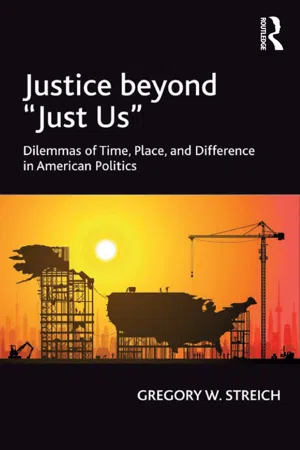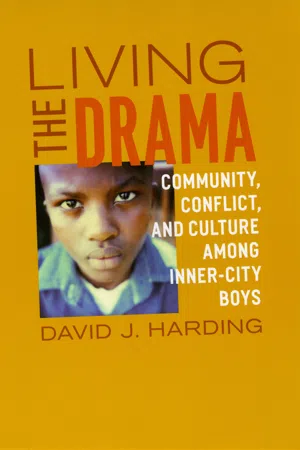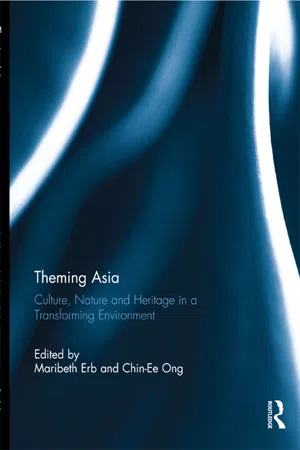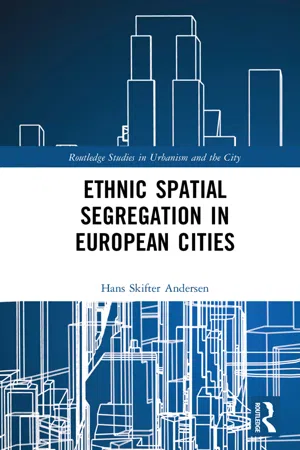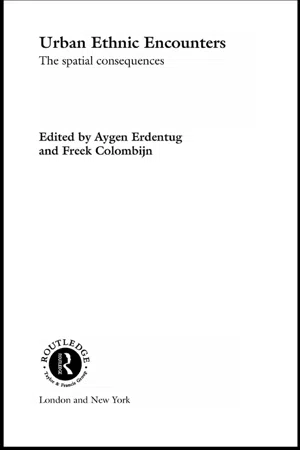Geography
Ethnic Neighborhoods
Ethnic neighborhoods are residential areas where a particular ethnic or cultural group is the majority. These neighborhoods often feature distinct cultural institutions, businesses, and social networks that cater to the needs and preferences of the specific ethnic group. They can contribute to the preservation and celebration of cultural traditions, but may also face challenges related to segregation and economic disparities.
Written by Perlego with AI-assistance
Related key terms
Related key terms
1 of 4
Related key terms
1 of 3
11 Key excerpts on "Ethnic Neighborhoods"
- eBook - ePub
- Mark Gottdiener, Randolph Hohle, Colby King(Authors)
- 2019(Publication Date)
- Routledge(Publisher)
When immigrants move to another country that contains people from varied origins, such as the United States, subcultural differences may take on the dimensions of ethnic distinctions. These are almost wholly symbolic or cultural in nature. In particular, ascribed characteristics and inherited beliefs may be applied to socially constructing differences among individuals of different foreign heritage. What counts for the dynamics of ethnicity is the extent to which those symbolic differences clash with those of the dominant society or of other ethnic groups in a diverse society. Even the categories of ethnic identity themselves can shift and change over time, as illustrated by Smajda and Gerteis’s (2012) study of Italian ethnic boundaries in Boston. In their study of the city’s North End neighborhood, at the time populated largely by Italian immigrants, they found an evolving sense of what it meant to be Italian in that neighborhood among residents, business owners, and politicians. Rather than observing an Italian ethnic identity that was weakening over time as members of the ethnic group assimilated, they found that the particular Italian ethnic identity dominated the culture and space of this neighborhood, and was often placed in contrast to social class identities and political boundaries, rather than other ethnic identities. Thus, this study illustrates the contrarian view that immigrants to America seek to assimilate into its larger culture. Consequently, the idea that all immigrants throughout the US invariably assimilate, except for those that are actively anti-American, is called into question.Although it is common to speak of Ethnic Neighborhoods in American cities—and most of us are familiar with Chinatowns, Mexican neighborhoods, Greektowns, and the like—urban sociologists are more likely to talk about the ethnic enclave, a concept which refers to an urban space with a concentration of members of one ethnic group who live, work, and typically operate small businesses within that space. The ethnic enclave emphasizes the ways in which social networks among residents of the same ethnic background, defined by a shared language, religion, history, or other customs, shapes the social life of the neighborhood. Much of this research focuses on the paradox of the ethnic enclave: the positive effects that social networks can provide for new immigrants, and the negative effects of concentration and isolation within the enclave. On the one hand, the ethnic enclave can be a resource for community support, at least for those residents able to leverage their status in the enclave to better themselves economically and/or politically (Portes and Zhou, 1993; Sanders and Nee, 1987). On the other hand, enclaves reinforce boundaries between different groups, leading to their exclusion from local political matters, thereby reinforcing exclusion. - eBook - ePub
- Eric Fong, Brent Berry(Authors)
- 2017(Publication Date)
- Polity(Publisher)
In Canada and the United States, ethnic concentration levels in neighborhoods are no longer related to the acculturation level of immigrant groups. As a result of changes to government immigration policies, many immigrants now arrive with considerable socioeconomic resources and/or high educational levels. Many are able to move right into a desirable location, such as a suburban neighborhood, and many choose to do so (Li 1998b). This means that residential choice is based not on acculturation level or socioeconomic necessity, but on the preference of immigrants according to their taste, such as living close to ethnic religious institutions and familiar cultural organizations (Logan et al. 2002). Changes in the configuration of urban spaces through high-rise development and suburbanization have also made it possible for many ethnic communities to emerge. Instead of using their socioeconomic resources to move into integrated neighborhoods, such as those where residents are predominantly White and local-born, many immigrants choose to live in affluent neighborhoods that are culturally familiar (Myles and Hou 2004). Logan et al. (2002) termed these neighborhoods, where residents have high socioeconomic status and tend to engage in the mainstream labor force, as “ethnic communities.” The socioeconomic demographics of the residents of these neighborhoods differ considerably from those of the Ethnic Neighborhoods described by the early Chicago School.Residential patterns also are affected by preferences about sharing neighborhoods with other racial groups (Bobo and Zubrinsky 1996; Charles 2001). Different groups tend to have different preferences about the racial and ethnic composition of neighborhoods, which can be viewed as one aspect of the bundle of preferred social amenities in neighborhoods. Individuals must decide how much they are willing to adjust their preference for a particular racial/ethnic composition in a neighborhood in order to gain some other desirable social amenities.Together, these two preferences for sharing neighborhoods, with one’s own group and with other groups, shape the residential patterns of immigrants. If groups prefer to stay with their own group members even after socioeconomic advancement, and prefer to live in highly co-ethnic concentrated areas rather than in neighborhoods with other social amenities, those immigrant groups will usually exhibit high levels of clustering.Empirical Findings on Residential Segregation of Immigrants
Ample evidence supports the theory that when immigrants arrive in a new country, they usually choose to live among their co-ethnic friends and family members, from whom they can seek assistance and support. The question is whether they gradually move into neighborhoods that are shared with other groups as they stay in the country longer or improve their socioeconomic resources. - eBook - ePub
From the Ground Up
Translating Geography into Community through Neighbor Networks
- Rick Grannis(Author)
- 2009(Publication Date)
- Princeton University Press(Publisher)
CHAPTER ONE
Neighborhoods and Neighboring
GEOGRAPHY AND COMMUNITY
Human behavior necessarily occurs within (or must transcend) physical space. Nowhere is this truer than in residential life. As real-estate agents and homeowners (especially those with children) often declare, where one makes one’s home matters almost as much as what one does inside it. In the rapidly shrinking world of the twenty-first century, psychologists, economists, political scientists, and sociologists still acknowledge the importance of the neighborhood context.Not all neighborhoods are alike, however. Some neighborhoods are characterized by high levels of effective community. They offer social capital to their residents, a social organization that facilitates and coordinates cooperative action for mutual benefit, which allows them to deal with daily life, seize opportunities, reduce uncertainties, and achieve ends that would not otherwise be possible.1 This social organization is a resource that is not individually attainable because social capital is not a characteristic of individuals; it is a supraindividual property of social structure, and it seems to be particularly well grounded in neighborhood communities.2 Sources of social capital tied to the neighborhood community are analytically distinct from, and are as consequential as, the more proximate family processes and relationships occurring in the home. Some neighborhoods develop a further layer of mutual trust and shared norms, values, and expectations,3 beyond the resource potential of neighbor networks, which allows them to use these networks to achieve desired outcomes. Collective efficacy occurs when members of a collectivity, with social capital resources, believe they are mutually able and willing to use them to achieve an intended outcome.4 - eBook - ePub
Problems of Youth
Transition to Adulthood in a Changing World
- Muzafer Sherif(Author)
- 2017(Publication Date)
- Routledge(Publisher)
PART IVAGE-MATE REFERENCE SETS WITHIN DIFFERENTIATED NEIGHBORHOODS
Passage contains an image
ELEVEN
URBAN NEIGHBORHOODS AND INDIVIDUAL BEHAVIOR
Wendell BellIt is a matter of everyday observation that metropolitan areas are subdivided into different sections, each exhibiting certain distinctive features. There are manufacturing, warehouse, theater, financial, department store, used car lot, residential, and many other districts in most modern American cities. The residential areas themselves are further differentiated with respect to many additional characteristics. Some are inhabited predominantly by Negroes, Chinese, Japanese, Puerto Ricans, Italians, Germans, Poles, Swedes, Mexicans, or some other racial or nationality group. Some districts are set apart from others because Jews, Catholics, or the members of a particular Protestant denomination live there in relatively large numbers.Some districts are characterized by old, dilapidated dwellings, or by large apartment houses, or by access to such desirable places as lake fronts, beaches, or river views, and still others by prominence of concrete, steel, asphalt, or general neglect. All urban areas have sections where the “rich people” live; others where the “poor people” live; and most urban subcommunities contain residents representing the many gradations in amount of wealth or income between these two extremes. Some neighborhood communities are marked by the presence of older persons, renters instead of home owners, more women than men, or certain occupations such as proprietors, professionals, managers, and officials. Others contain unskilled or semiskilled workers, or many unrelated individuals, or many persons living together in family units. - eBook - ePub
Sociological Human Ecology
Contemporary Issues And Applications
- Michael Micklin, Harvey M Choldin(Authors)
- 2019(Publication Date)
- Routledge(Publisher)
Despite the population melting pot theory, ethnicity still differentiates subcommunities to a considerable degree. Kantrowitz (1973) has shown that identifiable ethnic groups in the New York City area are still spatially concentrated and are segregated from other groups to some extent. Case studies in Chicago show traditional groupings of ethnic groups at different socioeconomic levels (see Suttles, 1968 and Kornblum, 1974, for poor and working-class examples and Molotch for middle-class examples). Suburban ethnicity has not been explored effectively, but there is reason to believe that suburbs have identifiable ethnic concentrations.Both the youthful and the aged segments of subcommunities affect local social life. Populations throughout the metropolitan areas are aging, with the exception of new suburban areas at the periphery which house young families. (The pattern of zonal distribution of families with children was presented by Anderson and Egelund, 1961). Declining fertility levels for several years have been having dramatic effects on subcommunities, the most dramatic being the lack of children to populate the schools. School closings are a major community issue throughout the nation. Entry of women into the workforce has also changed patterns of childrearing and local social life, leaving many households empty during the daytime.Although the depiction of “geriatric ghettoes” is over-drawn, there are more elderly persons toward the metropolitan center than at the periphery (Pampel and Gholdin, 1978). Now there are projections of the aging of the suburban population also as middle-aged couples retain their houses or move into suburban apartments.The principal demographic patterns affecting subcommunities are complex. The urban population is mobile, but not uniformly so. Most subcommunities have a considerable proportion of long-term stable residents. The urban population is heterogeneous, but there is clearly a sorting process by socioeconomic status and race/ethnicity. Individual subcommunities are clearly identifiable by status and race/ethnicity. The metropolitan population in general is aging, but subcommunities are also clearly differentiated by age and stage in the family life cycle, higher proportions of young families with children at the periphery and somewhat higher proportions of older persons toward the center. - eBook - ePub
Justice beyond 'Just Us'
Dilemmas of Time, Place, and Difference in American Politics
- Gregory W. Streich(Author)
- 2016(Publication Date)
- Routledge(Publisher)
First, Americans often equate their neighborhood and geographic locale with their “community.” Living together in a shared geographic place helps generate a collectively-shared identity for residents. The proximity of community members generates and sustains various social connections, ties, responsibilities, and obligations that bind members together as fellow members who treat each other as “one of us.” This not inherently problematic, nor is it avoidable. However, when place-based identities are constructed by contrasting one community against another, spatial markers can become divisive and invidious especially when those identities are singular, intensely held, exclusive, and overlap with ethno-racial or socio-demographic differences. This turns geographic locations into “turf” where insiders are “one of us” and outsiders are “one of them.” When Americans talk about “suburbs versus cities,” divide cities into sub-unites such as “East side versus West side” and “downtown versus uptown,” or distinguish middle-class suburbs from elite “gated” communities, these geographically-based labels are laden with symbolic meanings: rich people live here, poor people live there; white people live here, blacks and Latinos live there; trust these people, and fear those people.Second, when geographic boundaries establish the borders of one’s in-group, then obligations, responsibilities, and notions of justice are brought into the discussion. Residents of local communities and members of in-groups defend their rights, resources, opportunities, and advantages even if that means they are indifferent—or opposed—to the well-being of others who live in distant geographic locales with fewer opportunities, less resources, and more burdens than benefits. Localism is part of American political culture and provides some positive side-effects such as rich social networks and a sense of belonging, but it easily turns into parochialism in which people only care about justice for those who are geographically near and socio-demographically similar to themselves and do not care about the well-being and justice for those who are spatially distant and socio-demographically different (Theiss-Morse 2009 - eBook - ePub
Southeastern Geographer
Fall 2013 Issue
- David M. Cochran, Carl A. Reese, David M. Cochran, Carl A. Reese(Authors)
- 2013(Publication Date)
- The University of North Carolina Press(Publisher)
As noted by Wang and Walcott (2010), North American cities, including those in the Nuevo South, harbor ethnic and racial enclaves that promote entrepreneurial economies. Several studies have looked at the propensity of Latinos to establish ethnic enclaves in cities and metropolitan areas (e.g., McDaniel and Drever 2009; Wang and Walcott 2010); these enclaves act as self-organizing economic hubs for immigrant communities. In addition to urban enclaves, less populated centers outside the core metropolis are becoming locales of settlement, entrepreneurship and self-employment for ethnic communities (Oberle 2006; Li 2009). This is particularly true for Latinos, whose rapid growth in the Nuevo South extends past large urban centers and into suburban and rural communities (Kochlar et al. 2005). Within these suburban areas, Latinos are propagating unique ethnic spaces outside the traditional metropolitan enclaves; these include Walcott’s (2002) linear ethno-corridors, described as “international corridors” of [multi]ethnic residential and retail space along linear built environments (e.g., highways), as well as Li’s (1998) “ethnoburbs” that denote [multi]ethnic clusters of minority populations within the geographic boundaries of suburbs. These ethnically-defined geographic spaces—with their distinctive economies and socioeconomic influences—transform the geographic landscape both materially and symbolically (Kaplan and Li 2006; Furuseth 2010).In this paper, we explore the spatial heterogeneity and geographic diffusion of locally-owned Latino-cuisine restaurants3 - eBook - ePub
Living the Drama
Community, Conflict, and Culture among Inner-City Boys
- David J. Harding(Author)
- 2010(Publication Date)
- University of Chicago Press(Publisher)
Hannerz (1969) also provides evidence for cultural heterogeneity, not just across groups residing in a single neighborhood but also in the use of culture by individuals. For Hannerz, there are multiple forms of culture—norms and values, meanings, and modes of action—and each individual has a repertoire of these. Local subcultures can add to or substitute for items in the mainstream cultural repertoire and thereby provide adaptations and reactions to a given set of opportunities. Like Liebow (1967) and Anderson (1978), Hannerz sees local culture as helping individuals come to terms with contradictions between the wider society’s culture and the individual’s position in the social structure. Yet Hannerz makes clear that “ghetto culture” is not a monolithic entity but rather a heterogeneous mix of fluid ideal-type lifestyle groups (which he calls “mainstreamers,” “swingers,” “street families,” and “street corner men”). In ghetto neighborhoods, members of these groups live in close physical proximity, which often leads them to construct exaggerated social hierarchies and distinctions (see also Newman 1992). However, family ties and spatial proximity pull individuals with divergent lifestyles into regular contact and confrontation, diminishing the divisive moral judgments between lifestyle groups.A culturally heterogeneous neighborhood is one in which both mainstream and alternative cultural models are socially supported, so it is necessary to account for the presence of both types of models. A long line of previous social science research has illustrated how poverty and blocked opportunity result in the development of alternative cultural models, as individuals adapt to their circumstances by developing new status systems, new interpretations of their circumstances, and new ways to “get by.” In other words, urban ethnography has complicated the stark divisions of “ghetto culture” and “mainstream culture” implicit in social isolation theory, tending to see culture in disadvantaged neighborhoods as derived from mainstream culture but modified or reinterpreted to serve local needs and in response to blocked opportunities. For the men in Liebow’s Tally’s Corner (1967), Anderson’s A Place on the Corner (1978), and Duneier’s Slim’s Table (1992), failure to live up to values of the larger society (e.g., masculinity, marriage, economic self-sufficiency) because of blocked opportunities leads to the creation of a local status system that interprets the ideals of the larger society in light of those constructed locally. The local culture is less a new set of values than a set of alternative ways for locals to realize them.25Social organization theory also provides a clue as to why poor neighborhoods are culturally heterogeneous. The social-control capacity of those who endorse mainstream or conventional cultural models is often too low in poor enclaves to keep alternative or unconventional cultural models underground and out of public view. A lack of such strong social ties in poor neighborhoods means social control of alternative behaviors is diminished; local institutions are weak and collective behavior is more difficult (Shaw and McKay 1969).26 Sampson, Raudenbush, and Earls (1997), - eBook - ePub
Theming Asia
Culture, Nature and Heritage in a Transforming Environment
- Maribeth Erb, Chin Ee Ong(Authors)
- 2018(Publication Date)
- Routledge(Publisher)
Ethnic Neighborhoods are the epitome of contested space. Their meanings, identity, and roles in urban landscapes are constantly changing along with the shift of immigration patterns and political economies in metropolitan areas (Abramson, Manzo, & Hou, 2006). More recently, tourism has been introduced in many Ethnic Neighborhoods as a strategy of socioeconomic revitalization (Rath, 2007). Ethnic neighborhood tourism (ENT) is associated with commodifying the unique culture of these neighborhoods that cannot be easily found within other parts of the city or country as a whole. ENT essentially provides ‘authentic’ ethnic experiences for tourists without having to travel abroad to visit the actual culture (Loukaitou-Sideris & Soureli, 2011). With ENT, an ethnic neighborhood, a previously underprivileged ‘no-go’ area, can be reinvented as a space for leisure and consumption. However, this ‘reinvention’ can also add another source of tension within a community because reinventing an ethnic landscape may alter not only the identity of the place but also the locus of power to control vital economic and social resources (Bosak, Boley, & Zaret, 2010; Davis, 2005; Kolås, 2004; Verbeke, 1999). More precisely, ENT’s emphasis on promoting a particular culture may cause unequal distribution of power in controlling resources and benefits from tourism among locals as residents of the ethnic ‘majority’ do not have the same access to such cultural resources as the ethnic ‘minority’ (Maruyama, Woosnam, & Boley, 2016). This uneven distribution may then foster divergent attitudes toward tourism between the minority residents whose culture is on display and those of the majority population who live in the community but whose culture is not directly promoted and whose quality of life is being infringed upon (d’Hauteserre, 2001).Research on residents’ attitudes toward tourism has grown to become one of the most dominant areas of tourism research over the past four decades (e.g. Nepal, 2008; Nunkoo, Smith, & Ramkissoon, 2013; Ward & Berno, 2011; Zhang, Inbakaran, & Jackson, 2006). Additionally, work within the sustainable tourism literature has inextricably linked sustainable tourism with residents having favorable attitudes toward the industry and being empowered through the tourism development process (e.g. Choi & Murray, 2010; Cole, 2006; Látková & Vogt, 2012). Within this research, social exchange theory (SET) has long been the dominant theory used to examine residents’ attitudes toward tourism (Ap, 1992; Perdue, Long, & Allen, 1990; Ward & Berno, 2011). Despite the many benefits derived from SET’s clear depiction of resident attitudes being a cost–benefit analysis of the positive and negative impacts of tourism, the current use of SET in tourism research has been criticized for its simplicity, or ‘leaving out important theoretical constructs relevant to the theory’ (Nunkoo & Ramkissoon, 2011, p. 966). Indeed, more recent researchers have proposed new models that incorporate non-economic, sociocultural determinants, such as intergroup relations (Ward & Berno, 2011), power and trust (Nunkoo & Ramkissoon, 2011), quality of life (Kaplanidou et al., 2013), emotional solidarity (Woosnam, 2011), community attachment (Chen & Chen, 2010), social capital (Park, Nunkoo, & Yoon, 2015), and residents’ empowerment (Boley, McGehee, Perdue, & Long, 2014). With such sociocultural determinants being reported to have strong influence on the attitudes among those who do not enjoy direct economic benefits from tourism (Sirakaya, Teye, & Sönmez, 2002; Wang & Pfister, 2008), Boley et al. (2014) suggest the importance of combining SET with other more holistic theories to capture the complexities influencing resident attitudes toward tourism. This is especially important in ENT destinations where the economic benefits from ENT may not trickle down to all residents and the new place identity being promoted to tourists may be highly contested. - eBook - ePub
- Hans Skifter Andersen(Author)
- 2019(Publication Date)
- Routledge(Publisher)
Natives in countries with a high proportion of ethnic minorities are more often exposed to ethnic minorities in their neighbourhood. The important question is to what extent this has an influence on their preferences for the ethnic composition of their neighbourhood. The Nordic study examined both the attitudes to ethnically mixed neighbourhoods among residents living in multi-ethnic neighbourhoods and among people living outside. Moreover, they examined the differences between people who had moved recently from these neighbourhoods and people who had not. In general preferences for ethnics mixed among natives living in multi-ethnic neighbourhoods were not very different from those living outside multi-ethnic neighbourhoods. In Oslo there was a small tendency to higher support of ethnics mixing among natives living in multi-ethnic neighbourhoods. This is in accordance with the study conducted by Semyonov et al. (2007). They showed that preferences for ethnic homogeneity were much lower among those who currently lived in neighbourhoods where some or most residents were members of ethnic minorities, also when controlling for personal background factors like income and employment.The possible consequences of living in multi-ethnic neighbourhoods have been studied in the so-called contextual contact literature. This extensive research has been concerned with the question whether mixing of different ethnic groups in neighbourhoods promotes more tolerance between the groups or causes conflicts (Wessel 2009). As referenced in Andersson et al. (2017), American research shows that the implications of personal contacts between people are different from the impacts of more impersonal contacts found in larger urban areas than neighbourhoods, so-called contextual contacts. Research about personal contacts between the majority population and minorities shows that more personal contacts tend to reduce negative attitudes against minorities among the majority (Pettigrew and Tropp 2008). Research about contextual contact as found in larger urban areas, however, points towards increased negative attitudes. There seems to be greater resentment against ethnic minorities in cities with a larger population of ethnic minorities. Stein et al. (2000) conclude thus: ‘Ironically, our findings suggest that the very conditions [increasing minority density] that give rise to white hostility toward minority group members set in motion a corrective for this hostility: inter-group contact’. - eBook - ePub
Urban Ethnic Encounters
The Spatial Consequences
- Freek Colombijn, Aygen Erdentug(Authors)
- 2003(Publication Date)
- Routledge(Publisher)
Chapter 2 ) that residential segregation is the result of ethnic tensions. White supremacy, Darden argues, is an ideology which holds that in relations involving coloured people, the white race must have the superior position; this ideology restricts the opportunities of visible non-white minorities to attain equal neighbourhood qualities. The spatial consequence of white racism in Toronto is residential segregation. When the subordinate ‘races’ want to move up socially, moving out spatially from the formerly segregated neighbourhoods becomes a necessity. However, this is not at all easy to accomplish. In the comparable case of the USA, in spite of the fact that the law no longer supports racial segregation, the situation concerning the residential segregation of urban African-Americans has changed little since the 1950s. White people made up 94 per cent of the suburban population in 1977 and in 1990 this figure was still 94 per cent. African-Americans remain highly concentrated in inner cities, even when compared with Asian-Americans and Latinos. Scholars generally estimate that economic factors (differential housing costs in suburbs and inner cities, along with the low average income of the African-American population) account for only 10 per cent of African-American residential segregation (Darden 2001: 185–6; Phillips 1996: 437–8). The metaphor of the ‘ethnic melting-pot’ has remained illusory, since white people have adopted subtle ways of keeping African-Americans out of their neighbourhoods. The tricks employed include race baiting, rezoning, bank redlining (refusal to grant loans in areas around which red lines have been drawn) and racial steering by real-estate brokers (Darden 2001:186; Eriksen 1993: 139–1; McCarthy 1999: 324; Phillips 1996: 438; Quispel 1996: 334–7).One line of future research to refine on Darden’s conclusion that the Vietnamese are excluded from the highest-quality neighbourhoods would be to add a micro-level perspective. Such a perspective might perhaps reveal that an intervening variable can also partially explain his result: The percentage of home ownership–one characteristic of the composite neighbourhood-quality index–is viewed positively by the indigenous white population. Yet recent migrants, a category in which the Vietnamese are disproportionately represented, may prefer neighbourhoods with rented dwellings that can be occupied and left more easily. In other words, there are multiple perceptions of urban space.It is perhaps fitting to note here that the term ‘race’,2 as it is used here, should be treated as a particular mode of ethnicity (Eriksen 1993: 4–6; Jenkins 1997: 74–84). In a racist notion of society, ‘races’ are clearly bounded entities, visible by outward signs (such as the colour of skin and other physical features) that take on importance because of alleged hereditary personality traits. In reality, however, as is the case with all ethnic categorization, physical appearance only makes a difference because of the fact of it being socially signified as such. Despite the biological basis of the phenotype–the group of observable characteristics, produced by the genotype (basic structure of an organism) interacting with its environment, that make up an individual–the boundaries between ‘races’ are arbitrary. The arbitrariness of ‘racial’ categories is demonstrated by the Brazilian concept of branco
Index pages curate the most relevant extracts from our library of academic textbooks. They’ve been created using an in-house natural language model (NLM), each adding context and meaning to key research topics.
Explore more topic indexes
Explore more topic indexes
1 of 6
Explore more topic indexes
1 of 4
